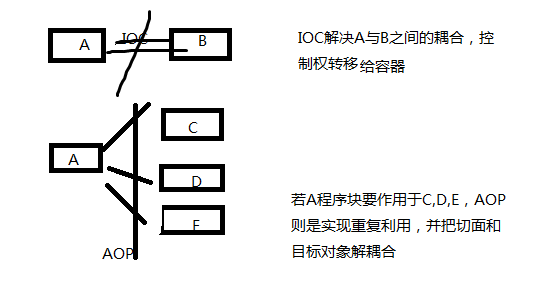Spring 核心是一个容器,核心机制为IOC和AOP
一、IOC 控制转移,也可称为解耦合,若没有spring容器,则action与dao直接相连,如若此action需要跟另一个dao相连或dao层发生变动,都需要大改程序,这种高度耦合的程序对于编程是不利的,spring的出现改变了这一现象,以往dao的控制权在于调用它的action,现在,把控制权交给spring容器,在配置文件中指定引用
配置文件applicationContext中可以使用setter方式注入也可以用构造方法注入
<!--setter方式-->
<bean id="ID名称" class="类全名"></bean>
如果类中含有其他类引用,在该action类中,dao类以属性方式存在,private 类型名称,补全setter方法
在配置文件中<property name="引用dao" ref="引用dao的ID"></property>
类中list,set,map等属性,在配置文件中分别为
<property><list><value>11</value><value>12</value></list></property>
<property><set><value>11</value><value>12</value></set></property>
<property><map><entry key="123" value="dadas"></entry><entry key="124" value="dadas"></entry></map></property>
<!--构造方式-->
<bean id="address" class="java.net.InetSocketAddress">
<constructor-arg index="0" value="127.0.0.1" />
<constructor-arg index="1" value="4449" />
</bean>
使用构造方法注入配置文件,,在类中用构造方法参数使用
自动扫描技术,避免配置文件中出现大量bean
在<beans></beans>中引入标签context,设置默认扫描包
<beans
xmlns="http://www.springframework.org/schema/beans"
xmlns:xsi="http://www.w3.org/2001/XMLSchema-instance"
xmlns:p="http://www.springframework.org/schema/p"
xmlns:context="http://www.springframework.org/schema/context"
xmlns:aop="http://www.springframework.org/schema/aop"
xsi:schemaLocation="http://www.springframework.org/schema/beans http://www.springframework.org/schema/beans/spring-beans-3.0.xsd
http://www.springframework.org/schema/context http://www.springframework.org/schema/context/spring-context-3.0.xsd
http://www.springframework.org/schema/aop http://www.springframework.org/schema/aop/spring-aop-3.0.xsd"
>
<!-- -自动扫描功能在容器中有标识类扫描 -->
<context:component-scan base-package="com.ss" />
在类名上加入标签
@Controller (一般action层)@Service(一般业务层) @Repository(一般dao层) @Component(其他层) 组件标识可以混用,不一定要在特点层特点,若后没有(“id自定义名称”)如@Repository("jdbcdao") 指定该层名称,则调用时一般默认为类名(首字母小写)(get bean("")时填入)。若类中存在引用其他类属性,则在该属性上部加入标签,否则报空指针异常。@Resource(name="bean对象的id名")

二、AOP 面向切面编程,若程序中需要使用某个程序块多次处理,比如打印日志监控,为避免麻烦,可以把程序块提取出来,在某些方法或类调用前后执行,类似过滤器概念
在配置文件beans中加入aop标签
xmlns:aop="http://www.springframework.org/schema/aop"
http://www.springframework.org/schema/aop http://www.springframework.org/schema/aop/spring-aop-3.0.xsd"
使用标签
<aop:config>
<!-- 切入点,指定目标对象或者方法 -->
<aop:pointcut id="daocut" expression="within(使用切面的目标类或方法例com.ss.ss.*)"/>
<!-- 切面,指定类,共同处理的组件 -->
<aop:aspect id="loggeraspect" ref="切块bean的id名">
<!-- 在方法前后执行-->
<aop:before method="需要执行的方法" pointcut-ref="切入点ID名"/>
</aop:aspect>
</aop:config>

AOP注解方式****
在主配置文件中引入<aop:aspectj-autoproxy/>
在切面类上定义@Aspect,先要确保此类被自动扫描
在类下定义一个空的方法作为切入点 @Pointcut("within(包)"),此定义必须为类或方法上,所以需自单独创建
例如@Pointcut("within(com.ss.*.*)")
public void daocut(){
}
在切面方法上定义通知@Around("daocut()")(环绕通知,此参数为切入点所在的空方法)
若通知方法为around,则所在方法中默认为带参数方法,参数为(ProceedingJoinPoint pjp)
此参数可以得到调用切面的类中的方法名
//获取调用类名
String classname=pjp.getTarget().getClass().getName();
//获取调用方法名
String methodname=pjp.getSignature().getName();
若通知方法为aop:after-throwing,则所在方法中的参数为(Exception ex)
在配置文件中<aop:after-throwing method="方法名" throwing="ex" pointcut-ref="切入点id"/>(追加throwing配置,值为参数名,保持一致)
ex中可以得到哪些类哪些方法出的那种类型的异常,例如
StackTraceElement[] message=ex.getStackTrace();
System.out.println(ex+"*****"+message[0]);
可以得到包名类名下方法报的类型错误
可以结合log4j将错误输出整理